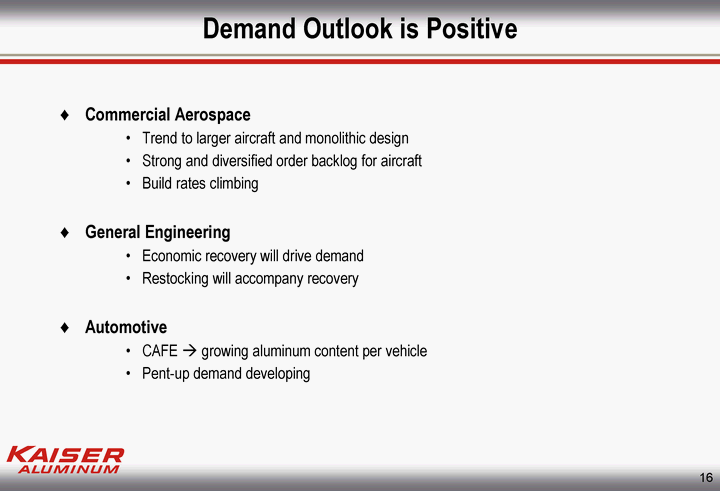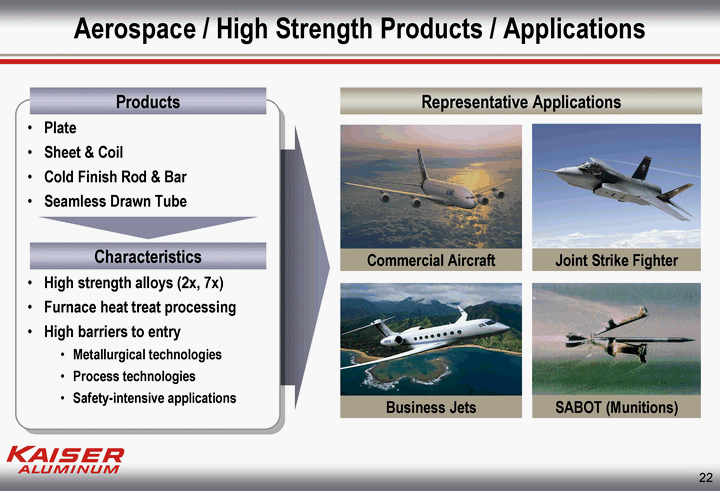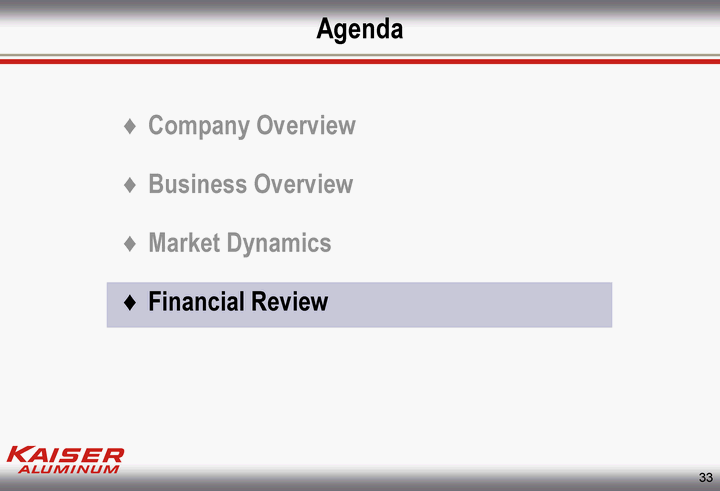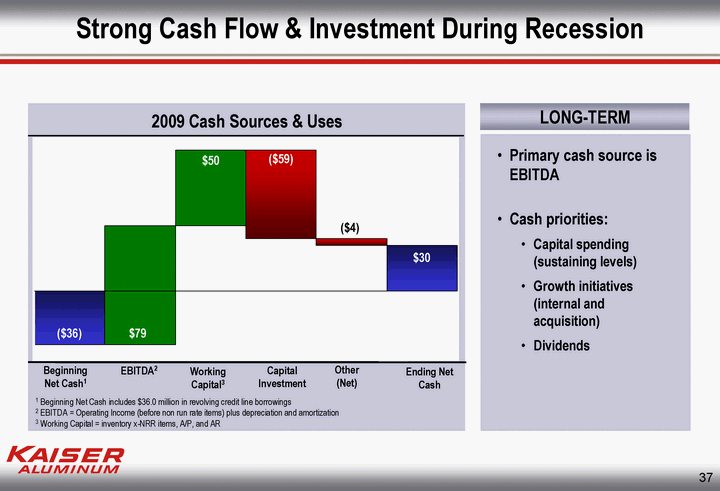Attached files
| file | filename |
|---|---|
| 8-K - FORM 8-K - KAISER ALUMINUM CORP | a55622e8vk.htm |
Exhibit 99.1

| Investor Presentation March 2010 |

| 2 Forward-Looking Statements The information contained in this presentation includes statements based on management's current expectations, estimates and projections that constitute "forward-looking statements" within the meaning of the Private Securities Litigation Reform Act of 1995. You should keep in mind that any forward-looking statements made by us speak only as of the date on which we make it. Our actual results or actions may differ materially from those projected in forward-looking statements. Such statements include statements regarding the company's anticipated financial and operating performance, relate to future events and expectations and involve known and unknown risks and uncertainties. For a summary of specific risk factors that could cause results to differ materially from those expressed in the forward-looking statements, please refer to the company's reports filed with the Securities and Exchange Commission. All information in this presentation is as of the date of the presentation. New risks and uncertainties arise from time to time, and it is impossible for us to predict these events or how they may affect us. The company undertakes no duty to update any forward-looking statement to conform the statement to actual results or changes in the company's expectations. |

| 3 Non-Run-Rate Items Non-run-rate items to us are items that, while they may recur from period to period, (1) are particularly material to results, (2) impact costs as a result of external market factors and (3) may not recur in future periods if the same level of underlying performance were to occur. These are certainly part of our business and operating environment but are worthy of being highlighted for the benefit of the users of our financial statements. Management's intent is to significantly neutralize the Fabricated Products segment from fluctuations in underlying metal prices. We characterize "metal profits" and LIFO charges as non-run-rate items that eventually offset to a great extent over the course of a full year. Further, presentations including such terms as net income or operating income "before non-run-rate" or "after adjustments" are not intended to be (and should not be relied on) in lieu of the comparable caption under generally accepted accounting principles ("GAAP") to which it is reconciled. Such presentations are solely intended to provide greater clarity of the impact of certain material items on the GAAP measure and are not intended to imply such items should be excluded. |

| 4 Non-GAAP Financial Measures This information contains certain non-GAAP financial measures. A "non-GAAP financial measure" is defined as a numerical measure of a company's financial performance that excludes or includes amounts so as to be different than the most directly comparable measure calculated and presented in accordance with GAAP in the statements of income, balance sheets or statements of cash flow of the company. The Company has provided a reconciliation of non-GAAP financial measures to the most directly comparable financial measure in the accompanying tables. The non-GAAP financial measures used are operating and EBITDA excluding non-run-rate and non- operating gains and losses. These measures are presented because management uses this information to monitor and evaluate financial results and trends and believes this information to also be useful for investors. |

| 5 Agenda Company Overview Business Overview Market Dynamics Financial Review |

| 6 Overview of Kaiser Aluminum Forgings Headquarters We produce semi-fabricated specialty aluminum products for select end market applications Our chosen end markets offer strong opportunities for profitable growth Aerospace and defense General engineering Automotive We manage the business to be metal price neutral, passing the price of aluminum through to customers, while earning a margin on fabrication Extrusions Sheet & Plate Drawn Products Facilities focus on specific products / applications Lean sigma employed for maximum efficiency Our Business Facilities Overview |

| '00 '01 '02 '03 '04 '05 '06 '07 '08 '09 Shipments 536.8 396.1 344.2 376 460.6 486.7 526.1 547.8 558.5 428.5 Net Sales 813.4 655.1 549.1 598.6 809.3 939 1158.1 1298.3 1336.8 897.1 VA $/# '00 '01 '02 '03 '04 '05 '06 '07 '08 '09 Shipments 536.8 396.1 344.2 376 460.6 486.7 526.1 547.8 558.5 428.5 Dollars 447.9 375.1 309.6 323.9 415.4 500.6 564.9 638.8 672.1 513.4 Dollars per Pound 0.83 0.95 0.9 0.86 0.9 1.03 1.07 1.17 1.2 1.2 7 Fabricated Products Sales Growth Value-added revenue = net sales less hedged cost of alloyed metal Millions of Pounds & Dollars Millions of Dollars Shipments & Net Sales Value-added Revenue 140 Value-added revenue reflects the profit opportunity Steady value-added revenue growth ~50% peak-to-peak and valley-to-valley Key growth drivers Aerospace plate demand growth Trentwood heat treat plate capacity expansion |

| 8 Consistent Operating Cash Flow 2005 2006 2007 2008 2009 East 97 105 165 130 79 1 Adjusted EBITDA = Operating Income (before non-run-rate items) plus depreciation and amortization, for details refer to 2009 form 10-K and our reconciliation of reported operating income to adjusted EBITDA in the appendix of this presentation 2 Financial information before July 1, 2006 relates to Kaiser before emergence from bankruptcy Adjusted EBITDA1 2 2 |

| 9 Investment Considerations Leading positions in strategic market segments High barriers to entry Low-cost producer and supplier of choice Blue chip customer base Well positioned to prosper as the economic rebound takes hold Approximately $250 million internal investments since 2006; full benefit yet to be realized Platform for long-term organic growth and complementary acquisitions Attractive markets Strong market presence and competitive position Financial strength and flexibility to support growth initiatives Consistent cash flow generation Modest leverage Significant U.S. tax attributes1 (~$900 million) 1 Refer to Kaiser's 2009 10-K for additional detail regarding tax attributes |

| 10 Fabricated Products Operations Experienced Management Jack Hockema President, CEO, Chairman Kaiser - 19 years Industry - 41 years John Barneson SVP Corporate Development Kaiser - 34 years Industry - 34 years Dan Rinkenberger SVP & CFO Kaiser - 19 years Industry - 19 years John Donnan SVP & General Counsel Kaiser - 16 years Industry - 16 years Jim McAuliffe SVP Human Resources Kaiser - 12 years Industry - 38 years Peter Bunin VP-GM Operations Kaiser - 13 years Industry - 21 years Keith Harvey VP Sales & Marketing Aerospace & Distribution Kaiser - 24 years Industry - 28 years Corporate |

| 11 Agenda Company Overview Business Overview Market Dynamics Financial Review |

| 12 Fabricated Products Portfolio Transition Offering included non-strategic products: Can stock Common alloy sheet & plate Castings Non-automotive forgings Forged truck wheels Competitive strength in strategic applications: Aerospace & defense General engineering Automotive Focused on Demanding Applications Where We Have Competitive Strength SHIPMENTS Non-Strategic (monetized) Strategic Strategic Today 1996 |

| 13 Served Market Segment Focus Focused on Demanding Applications Where We Have Competitive Strength Global Flat Rolled Products Market North American Extrusion Market Typical market size estimates from CRU, Aluminum Association, and Kaiser (based on industry shipments) Heat Treat Sheet & Plate General Engineering (rod, bar, tube) Light Vehicle Industrial Unserved Building & Construction Foil Can Stock Other Sheet & Plate Truck, Bus & Trailer Industrial Served Kaiser Unserved Market Segments Kaiser 'Non-Core' Served Market Segments Kaiser 'Core' Served Market Segments |

| 14 Well-positioned in Strategic Market Segments 1 Value-added revenue = net sales less hedged cost of alloyed metal Strong Competitive Position Market presence Leading positions in strategic market segments High barriers to entry Competitive strengths Broad product offering Best-in-Class service commitment Kaiser Select(r) products World-class facilities (quality, capability, cost) Profitable growth Realize potential from investments to date New investments in product line extensions and operating efficiency Acquisitions continually evaluated 1st Qtr 2nd Qtr 3rd Qtr 4th Qtr East 54 33 1 6 6 Kaiser 2009 Value-added Revenue 1 Kaiser 'Non-Core' Served Market Segments Kaiser 'Core' Served Market Segments Aerospace / High Strength 54% Automotive Extrusions 6% Other Custom 7% Cast Billet 1% General Engineering 32% |

| 15 Blue Chip Customer Base OEMs Service Centers |

| 16 Demand Outlook is Positive Commercial Aerospace Trend to larger aircraft and monolithic design Strong and diversified order backlog for aircraft Build rates climbing General Engineering Economic recovery will drive demand Restocking will accompany recovery Automotive CAFE ? growing aluminum content per vehicle Pent-up demand developing |

| 17 Financial Strength to Support Growth Initiatives Prudent liquidity & capital management Moderate leverage EVA-based investment criteria Significant U.S. tax attributes1 (~$900 million) Strong cash flows Profitable with positive cash flow through 2009 Maintained dividend through the downturn $250 million plus investment program funded internally since 2006 1 Refer to Kaiser's 2009 10-K for additional detail regarding tax attributes |

| 18 Internal Investment Initiatives Trentwood HT Plate Other (quality, efficiency, capacity) Kalamazoo Rod & Bar World-class heat treat plate expansion Trentwood, WA Completed late in 2008 New, world-class rod & bar plant Kalamazoo, MI Fully operational late 2010 Additional investments for quality and efficiency ~ $250 million investment since beginning of 2006 |

| 19 Trentwood Heat Treat Plate Expansion Continuous Heat Treat Furnace Plate Flow and Stretcher More than doubled heat treat plate capacity for aerospace and general engineering applications Expanded product offering to access growing heavy-gauge plate market Supported by underlying customer contracts Positioned Kaiser as industry leader for quality, cost and lead time |

| 20 New Kalamazoo Rod / Bar Plant 4000T Press Stretcher & Puller Equipment World-class Kaiser Select(r) remelt / extrusion plant Designed to position Kaiser as a premium quality, low cost producer of rod and bar for general engineering applications Expected to provide capacity for growing sales of extrusions for automotive applications Designed to accommodate future expansion |

| 21 Agenda Company Overview Business Overview Market Dynamics Financial Review |

| 22 Commercial Aircraft Joint Strike Fighter Business Jets SABOT (Munitions) Aerospace / High Strength Products / Applications Products Plate Sheet & Coil Cold Finish Rod & Bar Seamless Drawn Tube High strength alloys (2x, 7x) Furnace heat treat processing High barriers to entry Metallurgical technologies Process technologies Safety-intensive applications Representative Applications Characteristics |

| 23 Commercial Aerospace Trends Global economic growth drives growth in revenue passenger miles Longer routes and larger payloads drive demand for larger aircraft Rising fuel costs, aging fleet drive demand for replacement aircraft Source: Airline Monitor Jan/Feb 2010 Long-term Trends 1980 1981 1982 1983 1984 1985 1986 1987 1988 1989 1990 1991 1992 1993 1994 1995 1996 1997 1998 1999 2000 2001 2002 2003 2004 2005 2006 2007 2008 2009 2010 2011 2012 2013 2014 2015 2016 2017 2018 2019 2020 2021 2022 2023 2024 2025 2026 2027 2028 2029 2030 439 432 287 319 265 348 394 419 512 584 671 830 787 652 521 482 492 676 939 1104 1092 1173 984 895 897 918 1007 1068 1077 1156 1120 1160 1170 1200 1180 1150 1150 1200 1650 1800 1825 1500 1600 1850 2200 2600 2675 2800 2900 3150 3300 Area 2 0 0 0 0 0 0 0 0 0 0 0 0 0 0 0 0 0 0 0 0 0 0 0 0 0 0 0 0 0 0 Commercial Airframe >50 Seats Airframe Build Rates |

| 24 Aerospace Plate Demand Drivers Long-term Demand Drivers Aerospace Heat Treat Plate Growing build rates Larger airframes Monolithic design Composite materials Graphic Representation Larger Airframes and Monolithic Design Relative Aircraft Weight Plate Consumption per Aircraft Source: Kaiser estimates Composite aircraft consume significant aluminum plate |

| '00 '01 '02 '03 '04 '05 '06 '07 '08 '09 Shipments 75.9 93.7 50.9 70.3 91.3 124.9 141.7 155 157.7 144.7 '00 '01 '02 '03 '04 '05 '06 '07 '08 '09 Shipments 536.8 396.1 344.2 376 460.6 486.7 526.1 547.8 558.5 428.5 Dollars 148.4 172.9 97 116.1 149.1 223.6 255.6 297.4 323.8 278.1 Dollars per Pound 1.96 1.85 1.91 1.65 1.63 1.79 1.8 1.92 2.05 1.92 25 Value-added revenue = net sales less hedged cost of alloyed metal Millions of Pounds Millions of Dollars Shipments Value-added Revenue 140 Value-added revenue growth ~2x peak-to-peak and valley-to-valley Growth drivers Commercial aircraft build rates Step-change in heat treat plate usage - larger aircraft, monolithic design Trentwood heat treat plate expansion Aerospace / High Strength Trends |

| 26 Short-term Trends Long-term Trends Aerospace / High Strength Summary 1 15 14 13 12 11 10 9 8 7 6 5 4 3 2 YEARS Long-term demand outlook is positive Strong, diversified backlog for commercial aircraft Increased build rates pending (Boeing and Airbus) Larger aircraft + monolithic design F-35 Joint Strike Fighter funding Kaiser is well-positioned Demanding applications; high barriers to entry Strong competitive position throughout portfolio of products for aerospace / high strength applications Trentwood expansion; underlying sales contracts Anticipate increased destocking by airframe manufacturers in 2010 as they work through surplus inventories Destocking is abating for service center aerospace and high strength products |

| 27 General Engineering Products / Applications Products Plate Sheet Rod & Bar Pipe & Tube 6x series alloys Performance attributes Machinability Ballistics Representative Applications Tooling Plate Semiconductor Vacuum Chambers Air Cylinder Tubes Hydraulic Valve Bodies Armored Vehicles Parts From Select(r) Precision Rod Characteristics |

| '00 '01 '02 '03 '04 '05 '06 '07 '08 '09 Shipments 275.1 173.6 186.9 196.7 231.8 206.8 226.6 245.8 258.1 189 '00 '01 '02 '03 '04 '05 '06 '07 '08 '09 Shipments 536.8 396.1 344.2 376 460.6 486.7 526.1 547.8 558.5 428.5 Dollars 192.7 120.6 123.8 122.6 168.4 168.2 191.4 225.3 248.9 164.7 Dollars per Pound 0.7 0.69 0.66 0.62 0.73 0.81 0.84 0.92 0.96 0.87 28 Value-added revenue = net sales less hedged cost of alloyed metal Millions of Pounds Millions of Dollars Shipments Value-added Revenue 140 General Engineering Trends Demand drivers North American industrial production Supply chain destocking / restocking cycles Value-added revenue growth 30% peak-to-peak, 35% valley-to-valley driven by heat treat plate Armor plate demand General engineering plate $/# price driven by global heat treat plate supply shortage |

| 29 Long-term Trends General Engineering Summary 1 15 14 13 12 11 10 9 8 7 6 5 4 3 2 YEARS Long-term demand Economic recovery, restocking NA industrial growth Relatively strong armor demand Kaiser is well-positioned Strong market presence Broad product offering Best-in-Class service commitment Kaiser Select(r) products World-class Trentwood & Kalamazoo operations Service center inventories are substantially below levels seen during the 2001-2003 recession Anticipate gradual recovery in demand throughout supply chain to continue Short-term Trends |

| 30 Automotive Extrusions Products / Applications Products Custom extrusions Seamless extruded and drawn tube 4x/6x/7x series alloys Performance attributes Mechanical properties Machinability Formability Energy absorption Representative Applications Characteristics Drive Shafts Bumper Systems ABS Antilock Braking Systems |

| '00 '01 '02 '03 '04 '05 '06 '07 '08 '09 Shipments 536.8 396.1 344.2 376 460.6 486.7 526.1 547.8 558.5 428.5 Builds 17.2 15.5 16.4 15.9 15.8 15.8 15.3 15.1 12.6 8.6 # per vehicle 18 20.4 20.3 22.2 24.5 24.7 25.8 26 26.3 25.9 31 Automotive Extrusion Trends Kaiser Value-added Revenue North American Vehicle Builds Millions Millions of Dollars Pounds Per Vehicle Sources: February 2010 CSM Forecast, Aluminum Association Growing extrusion content per vehicle: 5% pounds per vehicle CAGR1 Expect continued growth driven by new CAFE standards (40% increase in fuel efficiency by 2020) Kaiser has a strong automotive track record and is well-positioned for future growth Balanced participation with traditional and new domestics Well-established market presence, capabilities, and competitive strength 8.5% value-added revenue per vehicle CAGR1 exceeds market growth '00 '01 '02 '03 '04 '05 '06 '07 '08 '09 Shipments 536.8 396.1 344.2 376 460.6 486.7 526.1 547.8 558.5 428.5 VA Revenue 29.5 29.6 30.9 27.4 34.8 40.3 38.8 50.7 41.6 31.3 VA $/# 1.715116279 1.909677419 1.884146341 1.72327044 2.202531646 2.550632911 2.535947712 3.357615894 3.301587302 3.639534884 Dollars Per N.A. Vehicle 1 Compound annual growth rate 2000-2008 (2009 trend statistics are distorted by supply chain destocking and step-change in build rate) |

| 32 Short-term Trends Long-term Trends Automotive Extrusions Summary 1 15 14 13 12 11 10 9 8 7 6 5 4 3 2 YEARS Long-term demand Cyclic auto build expected to return to pre-recession rates Growing extrusion content per vehicle Kaiser well-positioned Balanced customer mix of traditional and new domestics Demonstrated success supplying to demanding automotive applications 2009 N.A. build rate ~50% of the pre-recession rate 2010 build rates expected to rebound ~30% from 2009 |

| 33 Agenda Company Overview Business Overview Market Dynamics Financial Review |

| 34 Financial Strength and Flexibility Strong cash flows Maintain revolving credit facility for liquidity cushion Prudent liquidity & debt management Prudent leverage guidelines Available debt capacity to fund additional growth EVA-based investment criteria Significant U.S. tax attributes1 (~$900 million) Metal price neutrality 1 Refer to Kaiser's 2009 10-K for additional detail regarding tax attributes |

| 35 Metal Price Neutrality PRICING MECHANISM HOW IT WORKS EFFECT Spot Metal pass-through Index-Based Metal pass-through Firm Requires back-to-back hedge1 Kaiser can change selling price up to the point of shipment Price is a contractually negotiated conversion spread that "floats" over a published index Kaiser and customer agree to firm volume and price per pound 1 Hedging results in non-cash, mark-to-market gains or losses as metal prices fluctuate; for more details refer to 2009 Form 10-K We Pass-through Metal Price to Customers |

| 36 Capital Spending Funded From Adjusted EBITDA1 20052 20062 2007 2008 INTERNALLY FUNDED INVESTMENT Millions of Dollars Significant growth capital investments through 2009 Trentwood heat treat plate expansion (completed in 2008) Kalamazoo rod and bar project (will be fully operational in late 2010) Other plant investment initiatives completed EBITDA enabled internal funding Sustaining-level capital spending is $12 to $15 million annually Adjusted EBITDA1 Capital Spending 2009 $97 $105 $168 $130 $31 $58 $62 $93 $59 Sustaining-level capital spending is $12-$15M annually $79 $50-$60 2010 1 Adjusted EBITDA = Operating Income (before non-run-rate items) plus depreciation and amortization, for details refer to 2009 form 10-K and our reconciliation of reported operating income to adjusted EBITDA in the appendix of this presentation 2 Financial information before July 1, 2006 relates to Kaiser before emergence from bankruptcy |

| 37 Strong Cash Flow & Investment During Recession Beginning Net Cash1 EBITDA2 Working Capital3 Other (Net) 1 Beginning Net Cash includes $36.0 million in revolving credit line borrowings 2 EBITDA = Operating Income (before non run rate items) plus depreciation and amortization 3 Working Capital = inventory x-NRR items, A/P, and AR Ending Net Cash 2009 Cash Sources & Uses Capital Investment ($36) $50 $51 ($37) ($10) $15 Beginning Net Cash EBITDA Working Capital CapEx Other Uses Ending Net Cash white 43.5 34.6 30.3 blue -35.8 -35.8 30.3 orange 43.5 50.3 red 59.2 4.3 red ($36) $79 $50 ($59) $30 LONG-TERM Primary cash source is EBITDA Cash priorities: Capital spending (sustaining levels) Growth initiatives (internal and acquisition) Dividends ($4) |

| 38 Additional Financial Considerations SIGNIFICANT TAX ATTRIBUTES1 VEBA2 OBLIGATIONS Approximately $900 million of Net Operating Loss carryforwards and other tax attributes Applies to US and state pretax income Single-digit percentage cash tax rate (lower than book tax rate) Profit-sharing formula based on EBITDA less capital expenditures and other items VEBA payments capped at $20 million per year Replaced retiree medical obligations GAAP treatment as defined benefit plan 2 Voluntary Employee Benefit Association 1 Refer to Kaiser's 2009 10-K for additional detail regarding tax attributes |

| Investment Considerations Leading positions in strategic market segments Well positioned to prosper as economic rebound takes hold Strong platform for long-term organic growth and complementary acquisitions Financial strength and flexibility to support growth initiatives Experienced management team 39 |

| 40 Reconciliation of Reported Operating Income to Adjusted EBITDA1 1 Adjusted EBITDA = Operating Income (before non-run-rate items) plus depreciation and amortization 2 Totals may not sum due to rounding 3 NRR = non-run-rate items |

